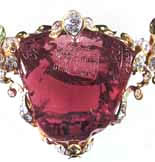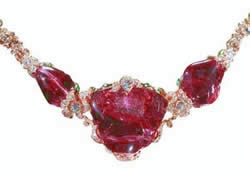




 Middle Name: Ruby
Middle Name: RubyMythology and Lore: Ruby is from the Latin word “ruber” or “rubrum” meaning red. Ruby and sapphire are among the oldest gems known to man, dating back many thousands of years. They were both held in very high regard, especially the ruby. The ancient Sanskrit name for ruby translate as king of precious stones or leader of precious stones.
Throughout history ruby has been said to preserve health and give invulnerability from wounds, and to guarantee that one’s status and possessions would never be taken. The wearing of a ruby was said to signify manhood, nobility & valour in a man, and pride & passion in a woman.
Ruby may be given on the 15th and 40th wedding anniversary. It has been said that the ruby’s red glow comes from an internal flame that cannot be extinguished, making a gift of this stone symbolic of everlasting love. Ruby is also associated with the zodiac sign of Aires.
Story of the Timur Ruby
 |
| Timur Ruby |
The famous Timur Ruby is in fact not a ruby; rather it is a spinel. It weighs over 352 carats and until 1851 was widely regarded as the largest known ruby in the world. Presented to Queen V
ictoria by the East India Company in October 1851
, and remaining amongst the collection of the British Royal family ever since, it has a long and colorful history.
Timur was a Tartar conqueror who is believed to have acquired the ruby when he sacked Delhi in 1398. He stayed in India for little over a year, before returning to Samarkand with the ruby among his spoils of war. The ruby was inherited by his son, Mir Shah Rukh, and later his grandson, Mirza Ulugli Beg.
During his rule there were many wars with the Pe
rsians and after one these, the ruby fell into the hands of Shah Abbas I of Persia, who in 1612 gave the ruby as a gift to his close friend, Jahangir, the Mughal Emperor of India. Jahangir had his name engraved on the ruby, as well as that of his father, Akbar. Legend has it that when his favorite wife rebuked him for defacing such a magnificent gem, he replied: "This jewel will more certainly hand down my name to posterity than any written history. The House of Timur may fall, but as long as there is a King, this jewel will be his."
Successive owners of the jewel continued to inscribe their names until Mahomed Farukh Siyar. The successor of this last of the Delhi emperors to in
scribe his name upon the gem was Nadir Shah, who sacked Delhi in 1739 and carried off the Timur Ruby among many other famous jewels to Isfahan.
He engraved the stone as follows:
 |
| Timur Ruby Necklace |
This (is) the ruby from among the 25,000 genuine jewels of the King of Kings, the Sultan Sahib Qiran [Timur], which in the year 1153 [1740 AD] from the (collection of) jewels of Hindustan reached this place [I
sfahan].
The last inscription on the Timur Ruby was made by Ahmad Shah, who was the commander of Nadir Shah's army at the time of his assassination in 1747. He attempted to seize the throne, but managed only to grab a large amount of
booty, which he took with him to help found the kingdom of Afghanistan.
However, the stone once again returned to India when the ruby eventually passed to his grandson Shah Suja. Expelled from his homeland, he took refuge in the Punjab, where Ranjit Singh, Lion of the Punjab, forced him to surr
ender the jewel.
And, like so many of the famous gems of the Orient, the Timur Ruby traveled to England amongst a collection of Indian jewelry taken from the Lahore Treasury in 1849 when Britain annexed the Punjab to its Empire.
Queen Victoria was well pleased by her gift - she particularly admired what she termed the wonderful rubies, and on 23 October 1851 wrote in her journal: They are cabochons, uncut, unset, but pierced. The one is the largest in the world, therefore even more remarkable than the Koh-i-noor!
In April 1853 Garrards set four of these so-called 'rubies' in a new diamond-encrusted gold and enamel necklace 'of Oriental design,' with four diamond pendants also from Lahore. At the center of the necklace came the huge rose-pink stone of 352 carats that Queen Victoria had especially noted. Two months later, Garrards adjusted the necklace to allow this stone to be detached for use as a brooch and to alternate with the recently recut
Koh-i-noor diamond.
Story of The Black Prince's Ruby









No comments:
Post a Comment